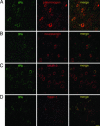Activity-dependent release of precursor nerve growth factor, conversion to mature nerve growth factor, and its degradation by a protease cascade
- PMID: 16618925
- PMCID: PMC1458950
- DOI: 10.1073/pnas.0510645103
Activity-dependent release of precursor nerve growth factor, conversion to mature nerve growth factor, and its degradation by a protease cascade
Abstract
In this report, we provide direct demonstration that the neurotrophin nerve growth factor (NGF) is released in the extracellular space in an activity-dependent manner in its precursor form (proNGF) and that it is in this compartment that its maturation and degradation takes place because of the coordinated release and the action of proenzymes and enzyme regulators. This converting protease cascade and its endogenous regulators (including tissue plasminogen activator, plasminogen, neuroserpin, precursor matrix metalloproteinase 9, and tissue inhibitor metalloproteinase 1) are colocalized in neurons of the cerebral cortex and released upon neuronal stimulation. We also provide evidence that this mechanism operates in in vivo conditions, as the CNS application of inhibitors of converting and degrading enzymes lead to dramatic alterations in the tissue levels of either precursor NGF or mature NGF. Pathological alterations of this cascade in the CNS might cause or contribute to a lack of proper neuronal trophic support in conditions such as cerebral ischemia, seizure and Alzheimer's disease or, conversely, to excessive local production of neurotrophins as reported in inflammatory arthritis pain.
Conflict of interest statement
Conflict of interest statement: No conflicts declared.
Figures







Similar articles
-
Cholinergic involvement in Alzheimer's disease. A link with NGF maturation and degradation.J Mol Neurosci. 2010 Jan;40(1-2):230-5. doi: 10.1007/s12031-009-9238-z. Epub 2009 Aug 13. J Mol Neurosci. 2010. PMID: 19680822 Review.
-
Amyloid beta-induced nerve growth factor dysmetabolism in Alzheimer disease.J Neuropathol Exp Neurol. 2009 Aug;68(8):857-69. doi: 10.1097/NEN.0b013e3181aed9e6. J Neuropathol Exp Neurol. 2009. PMID: 19606067
-
Nerve growth factor metabolic dysfunction in Down's syndrome brains.Brain. 2014 Mar;137(Pt 3):860-72. doi: 10.1093/brain/awt372. Epub 2014 Feb 11. Brain. 2014. PMID: 24519975 Free PMC article.
-
Differential deregulation of NGF and BDNF neurotrophins in a transgenic rat model of Alzheimer's disease.Neurobiol Dis. 2017 Dec;108:307-323. doi: 10.1016/j.nbd.2017.08.019. Epub 2017 Sep 1. Neurobiol Dis. 2017. PMID: 28865749
-
Gangliosides, NGF, brain aging and disease: a mini-review with personal reflections.Neurochem Res. 2012 Jun;37(6):1256-60. doi: 10.1007/s11064-012-0770-9. Epub 2012 Apr 8. Neurochem Res. 2012. PMID: 22484968 Review.
Cited by
-
Is Combining an Anticholinergic with a Cholinesterase Inhibitor a Good Strategy for High-Level CNS Cholinesterase Inhibition?J Alzheimers Dis. 2019;71(4):1099-1103. doi: 10.3233/JAD-190626. J Alzheimers Dis. 2019. PMID: 31476160 Free PMC article.
-
Subtilisin-like proprotein convertase expression, localization, and activity in the human retina and optic nerve head.Invest Ophthalmol Vis Sci. 2009 Dec;50(12):5759-68. doi: 10.1167/iovs.08-2616. Epub 2009 Apr 1. Invest Ophthalmol Vis Sci. 2009. PMID: 19339735 Free PMC article.
-
Can Wound Exudate from Venous Leg Ulcers Measure Wound Pain Status?: A Pilot Study.PLoS One. 2016 Dec 9;11(12):e0167478. doi: 10.1371/journal.pone.0167478. eCollection 2016. PLoS One. 2016. PMID: 27936243 Free PMC article.
-
c-Jun N-terminal Kinase Mediates Ligand-independent p75NTR Signaling in Mesencephalic Cells Subjected to Oxidative Stress.Neuroscience. 2021 Jan 15;453:222-236. doi: 10.1016/j.neuroscience.2020.11.036. Epub 2020 Nov 28. Neuroscience. 2021. PMID: 33253821 Free PMC article.
-
Astrocytes and Microglia-Mediated Immune Response in Maladaptive Plasticity is Differently Modulated by NGF in the Ventral Horn of the Spinal Cord Following Peripheral Nerve Injury.Cell Mol Neurobiol. 2016 Jan;36(1):37-46. doi: 10.1007/s10571-015-0218-2. Epub 2015 Jun 18. Cell Mol Neurobiol. 2016. PMID: 26084599 Free PMC article.
References
Publication types
MeSH terms
Substances
LinkOut - more resources
Full Text Sources
Other Literature Sources

